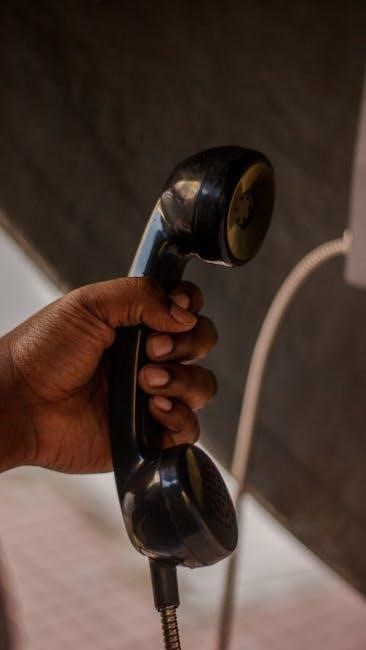The Kenwood 7400 Receiver is a high-quality audio device designed for optimal sound performance. Its robust build and advanced features make it a sought-after choice for audiophiles. The instruction manual is essential for proper setup, operation, and troubleshooting, ensuring users maximize its capabilities while maintaining safety and longevity.
1.1 Overview of the Kenwood 7400 Receiver
The Kenwood 7400 Receiver is a high-performance audio device known for its durability and advanced features. It delivers exceptional sound quality with precise tone controls and robust power output. Designed for versatility, it supports various speaker configurations and connectivity options. The receiver also features a monitor function for real-time audio adjustments, enhancing user control. Its intuitive interface and reliable performance make it a favorite among audiophiles. Understanding its operation through the manual ensures optimal use and maintenance, preserving its longevity and sound integrity.
1.2 Importance of the Instruction Manual
The instruction manual is crucial for safely operating and maintaining the Kenwood 7400 Receiver. It provides detailed guidance on installation, connectivity, and troubleshooting, ensuring optimal performance. The manual highlights safety precautions, such as handling high voltage components and proper grounding, to prevent damage or hazards. It also explains advanced features and customization options, helping users unlock the receiver’s full potential. Regular maintenance tips and alignment procedures are included to preserve sound quality and longevity. Without the manual, users may miss critical setup steps or overlook essential safety measures, risking equipment damage or personal injury. Referencing it ensures a seamless and enjoyable audio experience.
Key Features of the Kenwood 7400 Receiver
The instruction manual is vital for understanding the Kenwood 7400 Receiver’s features, ensuring safe operation, and troubleshooting issues. It provides detailed setup guidance, maintenance tips, and safety precautions, such as proper grounding and handling high voltage components. The manual also explains how to access advanced functions, align the tuner, and restore performance through capacitor replacement. Without it, users may overlook critical steps, leading to potential damage or suboptimal sound quality. Regularly referencing the manual ensures optimal functionality, longevity, and a safe, enjoyable listening experience tailored to the receiver’s capabilities.
2.1 Technical Specifications
The Kenwood 7400 Receiver boasts impressive technical specifications, delivering 63 watts per channel at 8 ohms, with compatibility for speakers ranging from 4 to 16 ohms. It features a frequency response of 20 Hz to 20 kHz, ensuring clear and balanced sound across all frequencies. The receiver includes a 12dB treble and bass control, allowing users to customize their audio experience. Grounding requirements and proper mounting angles (30° or less) are emphasized for safety and optimal performance. These specs highlight the receiver’s versatility and power, making it suitable for various audio setups while maintaining high-quality sound output and reliability.
2.2 Audio Quality and Power Output
The Kenwood 7400 Receiver delivers exceptional audio quality with a power output of 63 watts per channel at 8 ohms. Its robust design ensures minimal distortion and clear sound reproduction. The receiver supports a wide range of frequencies, from 20 Hz to 20 kHz, providing a rich and balanced listening experience. With a signal-to-noise ratio optimized for low hum and noise, it maintains pristine audio clarity. The built-in tone controls allow for precise adjustments to treble and bass, enhancing the overall audio quality. This combination of power and precision makes the Kenwood 7400 a reliable choice for immersive sound.
2.3 Connectivity Options
The Kenwood 7400 Receiver offers versatile connectivity options to cater to various audio needs. It features multiple inputs, including Phono, Phono 2, FM, AM, and auxiliary, allowing seamless integration with external devices. The receiver supports both RCA and speaker-level connections, ensuring compatibility with a wide range of speakers and components. Grounding terminals are provided for optimal signal-to-noise ratio and reduced interference. For professional setups, the unit can be mounted at an angle of 30 degrees or less, ensuring stability and proper heat dissipation. These connectivity features enhance the receiver’s versatility, making it suitable for both home and professional audio systems. Proper handling and grounding are essential for optimal performance.
Installation and Setup
Installation involves unpacking, grounding, and mounting the receiver at 30 degrees or less. Proper handling and professional assistance are recommended for safe and optimal setup.
3.1 Unpacking and Preparing the Receiver
When unpacking the Kenwood 7400 Receiver, carefully remove all components from the box. Inspect for damage and ensure all accessories are included. Before powering on, ground the unit to prevent electrical interference. Use a fine-point, low-wattage soldering iron for any internal adjustments. Handle components gently to avoid static discharge. Refer to the service manual for detailed unpacking and preparation steps to ensure safety and optimal performance. Proper preparation is crucial for maintaining the receiver’s functionality and longevity.
3.2 Mounting the Receiver
Mounting the Kenwood 7400 Receiver requires careful attention to ensure proper installation and safety. The unit should be mounted at an angle of 30 degrees or less to prevent damage. For best results, leave mounting and wiring to professionals. Use a fine-point, low-wattage soldering iron (less than 45W) and high-quality tools for any adjustments. Ensure the receiver is securely fastened to avoid movement during operation. Grounding the unit is crucial to prevent electrical interference and ensure optimal performance. Always follow the service manual guidelines for mounting to maintain safety and functionality.
3.3 Connecting Speakers and External Devices
Connecting speakers and external devices to the Kenwood 7400 Receiver requires careful attention to ensure proper functionality. The receiver is rated at 63 watts per channel at 8 ohms and supports speakers with impedances between 4-16 ohms. Use high-quality RCA cables for external devices and ensure left and right channels are connected correctly. Before connecting, turn off all devices to prevent damage. Grounding the unit is essential to minimize interference. Refer to the service manual for detailed diagrams and connection guidelines. Proper connections ensure optimal audio quality and prevent potential damage to the receiver or speakers.
3.4 Grounding the Unit for Safety
Grounding the Kenwood 7400 Receiver is crucial for safe operation and optimal performance. Proper grounding prevents electrical interference, hum, and potential damage from voltage surges. Use a high-quality grounding cable and connect it to a reliable earth point, such as a metal chassis or grounding terminal. Ensure all connections are secure and free from corrosion. Improper grounding can lead to safety hazards, including electrical shock or fire risks. Refer to the service manual for detailed grounding procedures and diagrams. Always prioritize grounding to safeguard both the receiver and external devices connected to it. Proper grounding ensures long-term reliability and audio clarity.

Operating the Kenwood 7400 Receiver
Operating the Kenwood 7400 Receiver involves mastering its intuitive controls and functions. Familiarize yourself with the front panel, remote, and menu system for seamless audio management and customization.
4.1 Basic Controls and Functions
The Kenwood 7400 Receiver features a user-friendly interface with essential controls for seamless operation. The front panel includes a volume knob, AM/FM button, and multi-function buttons for input selection and menu navigation. The remote control provides additional convenience, allowing you to adjust settings and switch modes effortlessly. Understanding these basic functions is key to optimizing your listening experience. Familiarize yourself with the button layouts and their purposes to ensure smooth operation and access to advanced features as needed.
4.2 Adjusting Tone Controls
The Kenwood 7400 Receiver offers precise tone controls, allowing you to customize your audio experience. Adjust the treble and bass settings using the dedicated knobs or the menu system. The tone controls provide a range of -12dB to +12dB for both treble and bass, enabling fine-tuning to suit your preferences. For a balanced sound, start with the controls at the midpoint and make small adjustments. Experimenting with these settings can enhance clarity, depth, and overall listening enjoyment. Use the tone controls to optimize your audio for different genres of music or external devices connected to the receiver.
4.3 Selecting Input Sources
The Kenwood 7400 Receiver offers multiple input options, including Phono, AM, FM, and auxiliary sources. To select an input, press the multi-button to access the menu and navigate to the input selection option. Choose the desired source from the list, ensuring it matches the connected device. For example, select “Phono” for turntables or “Aux” for external devices. Once selected, the receiver will output audio from the chosen source. Use the monitor function to preview or listen to the selected input before finalizing your choice. Properly connecting devices to the correct ports ensures optimal performance and clear audio output. Always refer to the manual for specific input pairing instructions.
4.4 Using the Monitor Function
The Monitor function on the Kenwood 7400 Receiver allows users to preview or listen to the selected input source before finalizing playback. To activate this feature, press the multi-button located on the top right of the display. A menu will appear; navigate to the Monitor option and tap it to toggle the function on or off. This feature is particularly useful for ensuring the correct input is selected or for troubleshooting audio issues, such as imbalance between speakers. Proper use of the Monitor function ensures seamless audio switching and optimal listening experiences.

Advanced Features and Customization
The Kenwood 7400 Receiver offers advanced audio customization, including tone controls, special sound modes, and equalizer settings, allowing users to tailor their listening experience to preference.
5.1 Audio Customization Options
The Kenwood 7400 Receiver provides extensive audio customization options, allowing users to fine-tune their sound preferences. With adjustable treble and bass controls, listeners can enhance specific frequency ranges for a personalized listening experience. Additionally, the receiver features a built-in equalizer, enabling precise tonal adjustments to match different music genres or speaker setups. These customization options are easily accessible via the receiver’s intuitive interface, ensuring that users can optimize their audio settings without complexity. By leveraging these features, users can achieve a sound quality that aligns perfectly with their auditory preferences. Regular updates and adjustments can further enhance the listening experience.
5.2 Special Sound Modes
The Kenwood 7400 Receiver offers several special sound modes to enhance your listening experience. These include Mono, Stereo, and Loudness modes, each tailored for specific audio scenarios. The Mono mode ensures balanced sound across all speakers, while Stereo mode emphasizes channel separation for immersive audio. Loudness mode boosts low-frequency response, ideal for low-volume listening. Additionally, the receiver features a monitor function, allowing users to compare original and processed audio signals. These modes provide flexibility and customization, enabling users to optimize sound quality based on their preferences or the type of content being played. This versatility makes the Kenwood 7400 a versatile choice for diverse audio needs.
5.3 Equalizer Settings
The Kenwood 7400 Receiver features adjustable equalizer settings, allowing users to fine-tune audio frequencies for a customized listening experience. The tone controls enable adjustments to treble and bass levels, with options to boost or cut frequencies. These settings can be applied globally or to specific input sources, providing flexibility for different types of music or audio content. The equalizer settings are accessed via the receiver’s menu, where users can precisely tailor the sound to their preferences. Proper use of these controls, as outlined in the manual, ensures optimal audio quality and enhances the overall performance of the receiver.

Troubleshooting Common Issues
This section guides users through diagnosing and resolving common problems, such as audio issues or connectivity faults, ensuring optimal performance and longevity of the Kenwood 7400 Receiver.
6.1 Diagnosing Audio Problems
Diagnosing audio issues with the Kenwood 7400 Receiver involves checking connections, volume settings, and speaker balance. Ensure all cables are securely plugged in and free from damage. If sound is uneven, adjust the balance control. For no audio, verify the input source and mute function. Distortion may indicate improper settings or faulty components. Refer to the manual for detailed troubleshooting steps to identify and resolve issues efficiently, ensuring optimal sound quality and performance from your receiver.
6.2 Resolving Connectivity Issues
Connectivity issues with the Kenwood 7400 Receiver can often be resolved by checking cable connections and ensuring proper input selection. Verify that all RCA and speaker wires are securely plugged in and free from damage. If using external devices, confirm they are turned on and set to the correct output mode. For wireless connections, ensure antennas are properly attached and positioned. Refer to the manual for guidance on resetting or reconfiguring connections. Additionally, using the monitor function can help identify signal strength and stability, aiding in troubleshooting. Regularly cleaning and inspecting ports can prevent connectivity problems.
6.3 Fixing Distortion or Noise
To address distortion or noise on the Kenwood 7400 Receiver, first check all connections for loose or damaged cables. Ensure proper grounding to prevent interference. Adjusting tone controls or equalizer settings can help minimize unwanted frequencies. If distortion persists, inspect speakers for damage or improper impedance matching. Clean the unit’s internal components and replace worn capacitors if necessary. For hissing or hum, verify grounding and ensure no external devices are causing interference. Refer to the manual for alignment procedures or seek professional assistance for internal adjustments. Regular maintenance can prevent such issues and maintain optimal sound quality.

Maintenance and Restoration Tips
Regularly clean the Kenwood 7400 Receiver to prevent dust buildup. Replace capacitors and worn components to restore optimal performance. Align the tuner section for clear reception.
7.1 Cleaning the Receiver
To maintain the Kenwood 7400 Receiver’s performance, clean it regularly. Power it off and unplug it before cleaning. Use a soft, dry cloth to wipe the exterior, removing dust and fingerprints. Avoid using liquids or harsh chemicals, as they may damage the finish or harm internal components. Gently clean knobs, buttons, and vents with a slightly damp cloth, ensuring no moisture enters the unit. For stubborn stains, dampen a cloth with distilled water, but avoid excessive moisture. Clean the receiver every 2-3 months to prevent dust buildup. Never spray cleaning products directly on the unit. For internal cleaning, consult a professional technician to avoid damage. Regular maintenance ensures optimal functionality and preserves the receiver’s longevity. Always handle the unit with care to prevent scratches or electrical issues.
7.2 Replacing Capacitors and Components
Replacing capacitors and components in the Kenwood 7400 Receiver requires caution and technical skill. Start by disconnecting the power source and discharging capacitors to avoid electrical shock. Use a fine-point, low-wattage soldering iron (less than 45W) for replacing faulty capacitors or components. Carefully remove the old parts and install new ones, ensuring proper soldering. Refer to the service manual for specific instructions and schematic diagrams. Regular capacitor replacement, known as “recapping,” is crucial for restoring the receiver to its original specifications. Improper handling can damage the unit, so consider consulting a professional technician if unsure. Proper replacement ensures optimal performance and longevity. Always use high-quality components to maintain sound quality and reliability.
7.3 Aligning the Tuner Section
Aligning the tuner section of the Kenwood 7400 Receiver ensures optimal performance and clear signal reception. Start by accessing the tuner alignment procedure in the service manual. Use a signal generator and oscilloscope to adjust the tuner’s frequency response. Carefully align the coils and capacitors to match the specified settings. Proper grounding is essential to prevent interference. If unfamiliar with alignment techniques, consider consulting a professional technician. Regular alignment maintains the receiver’s accuracy and sound quality. Follow the manual’s instructions precisely to avoid damaging the tuner or other components. Proper alignment ensures reliable operation and enhances overall listening experience.
Understanding the User Manual
The Kenwood 7400 Receiver’s user manual provides comprehensive guidance for installation, operation, and troubleshooting. It includes detailed diagrams, specifications, and safety precautions to ensure optimal functionality and user safety.
8.1 Navigating the Manual
Navigating the Kenwood 7400 Receiver manual is straightforward due to its organized structure. The manual begins with essential safety precautions, followed by installation guidelines and operational instructions. Troubleshooting sections help diagnose common issues, while the appendix provides technical specifications and diagrams. Each section is clearly labeled, making it easy to find specific information quickly. Users can refer to the table of contents or index for direct access to desired topics, ensuring efficient navigation and comprehensive understanding of the receiver’s features and maintenance requirements.
8.2 Interpreting Schematic Diagrams
The Kenwood 7400 Receiver’s manual includes detailed schematic diagrams to aid in troubleshooting and repairs. These diagrams provide a visual representation of the receiver’s internal circuitry, highlighting components like resistors, capacitors, and transistors. Users can identify faulty parts by cross-referencing symptoms with the diagrams. Color-coded wires and symbols ensure clarity, while numbered reference points simplify navigation. For accuracy, always use the provided legend to decipher symbols and connections. Proper interpretation requires basic electronics knowledge and the use of appropriate tools. This section is invaluable for technicians and enthusiasts aiming to restore or upgrade the receiver’s performance effectively.
8.3 Service Manual Recommendations
The Kenwood 7400 Receiver’s service manual provides detailed repair and maintenance guidelines. It recommends using genuine Kenwood parts for replacements to ensure compatibility and performance. Regular capacitor replacement is advised to maintain sound quality and prevent distortion. For complex repairs, such as tuner alignment or circuit board work, professional expertise is strongly recommended. The manual also suggests periodic cleaning of internal components to avoid overheating and signal interference. Following these recommendations ensures optimal performance, extends the receiver’s lifespan, and prevents costly damages. Always refer to the service manual before attempting any repairs or upgrades for safe and effective results.

Safety Precautions
Handle the Kenwood 7400 Receiver with care to avoid electrical shock or damage. Never touch internal components while powered on. Keep the unit away from water and ensure proper ventilation to prevent overheating. Ground the receiver correctly to avoid electrical hazards. Avoid exposing the device to extreme temperatures or physical stress. Always unplug before servicing and consult a professional for complex repairs to ensure safety and maintain functionality.
9.1 High Voltage Warnings
The Kenwood 7400 Receiver contains high-voltage components that can cause severe electrical shock or injury. Never touch internal components while the unit is powered on. Always disconnect the power source before servicing. High voltage areas, such as the power amplifier section, should be handled with extreme caution. Proper grounding is essential to prevent electrical hazards. Avoid exposing the unit to moisture or conducting repairs without proper training. High voltage can result in fatal injuries if not handled correctly. Ensure all safety measures are followed to protect yourself and maintain the receiver’s functionality. Always consult a qualified technician for internal repairs or adjustments.
9.2 Proper Handling of Electrical Components
When handling electrical components of the Kenwood 7400 Receiver, ensure all power sources are disconnected. Avoid touching circuit boards or internal parts to prevent damage from static electricity. Use an anti-static wrist strap or grounded tool. Never force connectors or cables, as this may cause permanent damage. For soldering, use a low-wattage iron and avoid prolonged heat exposure. If unsure about any procedure, consult the service manual or seek professional assistance. Proper handling ensures the longevity and reliability of the receiver, preventing costly repairs and potential safety hazards. Always follow the manufacturer’s guidelines for safe and effective maintenance.
9.3 Avoiding Overheating
To prevent overheating, ensure the Kenwood 7400 Receiver is placed in a well-ventilated area, away from direct sunlight or heat sources. Avoid blocking ventilation openings, as this can restrict airflow. Mount the unit at an angle of 30 degrees or less to maintain proper cooling. Never operate the receiver near flammable materials or in confined spaces. If the unit feels unusually warm, turn it off and allow it to cool. Regularly inspect for dust buildup, which can impede cooling. Using the receiver at moderate power levels and adhering to these guidelines will help prevent overheating and extend its lifespan.
Warranty and Support Information
Kenwood offers a limited warranty for the 7400 Receiver, covering manufacturing defects. Register your product for warranty validation. Contact Kenwood support for assistance or visit authorized service centers.
10.1 Warranty Coverage Details
The Kenwood 7400 Receiver comes with a limited warranty that covers defects in materials and workmanship. The standard warranty period is one year from the date of purchase. During this time, Kenwood will repair or replace defective parts free of charge. The warranty applies to the original purchaser and is non-transferable. For warranty claims, users must provide proof of purchase and contact Kenwood support directly. Additionally, the warranty does not cover damages resulting from misuse, improper installation, or unauthorized modifications. Always refer to the official warranty document for detailed terms and conditions.
10.2 Contacting Kenwood Support
Contacting Kenwood Support is straightforward for assistance with your 7400 Receiver. Visit their official website to find contact details, including phone numbers and email addresses. Additionally, Kenwood offers live chat support for quick inquiries. Ensure to have your product serial number and purchase details ready for efficient service. For repair or maintenance, Kenwood recommends using authorized service centers. Refer to the service manual for troubleshooting guidance before contacting support. Their team is available to address technical issues, warranty claims, or general inquiries, ensuring optimal performance and longevity of your receiver.
10.3 Finding Authorized Service Centers
To locate authorized service centers for your Kenwood 7400 Receiver, visit Kenwood’s official website and navigate to the “Support” or “Service Centers” section. Enter your location to find nearby authorized centers. These centers are equipped to handle repairs, maintenance, and upgrades, ensuring your receiver is serviced to factory standards. For complex issues like capacitor replacement or tuner alignment, authorized centers are recommended to maintain warranty validity and ensure safety. Always verify the center’s authorization status before proceeding with any service to guarantee authentic Kenwood parts and expert care.
The Kenwood 7400 Receiver offers exceptional audio quality and versatility. By following the manual, users can optimize performance, troubleshoot issues, and extend the product’s lifespan effectively.
11.1 Final Tips for Optimal Performance
For the best experience with your Kenwood 7400 Receiver, ensure regular cleaning and proper ventilation to prevent overheating. Always use high-quality cables and connections to maintain sound integrity. Adjust tone controls carefully to avoid distortion. Refer to the manual for alignment and calibration procedures. Ground the unit correctly to eliminate noise. Avoid overloading the receiver with too many external devices; Finally, store the manual in an accessible location for quick reference during troubleshooting or adjustments.
11.2 Resources for Further Assistance
For additional support with your Kenwood 7400 Receiver, refer to the official Kenwood website or authorized service centers. Downloadable manuals are available on platforms like Hifi Engine. Online forums and communities, such as Reddit’s home audio groups, offer user experiences and troubleshooting tips; Professional technicians can assist with complex repairs. Ensure to verify the credibility of any third-party resources. Regularly check Kenwood’s official support page for updates or FAQs. These resources will help you maintain and enhance your receiver’s performance effectively.
